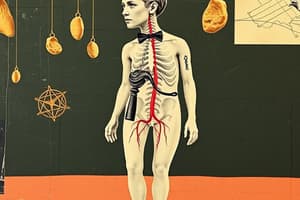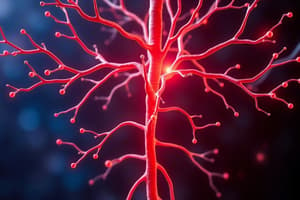Podcast
Questions and Answers
What occurs when body temperature rises?
What occurs when body temperature rises?
- Sweat glands are activated (correct)
- Cutaneous blood vessels constrict
- Sympathetic nerves decrease activity
- Blood pressure is lowered
What is one of the effects of the Renin-Angiotensin-Aldosterone mechanism?
What is one of the effects of the Renin-Angiotensin-Aldosterone mechanism?
- Lowering blood glucose levels
- Dilation of blood vessels
- Increasing blood pressure (correct)
- Decreasing metabolic rate
What primarily increases to provide energy during fight or flight?
What primarily increases to provide energy during fight or flight?
- Insulin secretion
- Tissue oxygenation
- Metabolic rate of cells (correct)
- Muscle tone
Which drug acts as a nicotinic cholinergic receptor antagonist?
Which drug acts as a nicotinic cholinergic receptor antagonist?
How do the sympathetic and parasympathetic divisions primarily function?
How do the sympathetic and parasympathetic divisions primarily function?
What effect does scopolamine have on the body?
What effect does scopolamine have on the body?
What type of autonomic receptor do epinephrine and norepinephrine primarily bind to?
What type of autonomic receptor do epinephrine and norepinephrine primarily bind to?
What is a common role of pre-workouts and fat burners?
What is a common role of pre-workouts and fat burners?
What type of muscles does the autonomic nervous system innervate?
What type of muscles does the autonomic nervous system innervate?
Which neurotransmitter is released by postganglionic fibers in the sympathetic division?
Which neurotransmitter is released by postganglionic fibers in the sympathetic division?
Which division of the autonomic nervous system is responsible for the fight or flight response?
Which division of the autonomic nervous system is responsible for the fight or flight response?
Which of the following statements about the autonomic nervous system is correct?
Which of the following statements about the autonomic nervous system is correct?
How does the parasympathetic division typically affect heart rate?
How does the parasympathetic division typically affect heart rate?
What type of receptors are activated by acetylcholine in the autonomic nervous system?
What type of receptors are activated by acetylcholine in the autonomic nervous system?
Which statement about the sympathetic and parasympathetic divisions is true?
Which statement about the sympathetic and parasympathetic divisions is true?
Which process is typically promoted by the parasympathetic division?
Which process is typically promoted by the parasympathetic division?
What is the primary effect of activating alpha adrenergic receptors?
What is the primary effect of activating alpha adrenergic receptors?
Which of the following accurately describes the preganglionic fibers of the sympathetic division?
Which of the following accurately describes the preganglionic fibers of the sympathetic division?
Flashcards
Sympathetic Response to Heat
Sympathetic Response to Heat
When body temperature rises, the sympathetic nervous system dilates blood vessels in the skin to facilitate heat loss and activates sweat glands to cool the body through evaporation.
Renin Release by Sympathetic System
Renin Release by Sympathetic System
The sympathetic nervous system stimulates the kidneys to release renin, which triggers a cascade of events leading to increased blood pressure. This is important for maintaining blood pressure during fight-or-flight.
Metabolic Effects of Sympathetic Activation
Metabolic Effects of Sympathetic Activation
The sympathetic nervous system increases the metabolic rate of cells, leading to increased blood glucose levels through glycogen breakdown and fat burning for energy. This provides the body with the necessary fuel for fight-or-flight.
Autonomic Nervous System
Autonomic Nervous System
Signup and view all the flashcards
Sympathetic Division
Sympathetic Division
Signup and view all the flashcards
Parasympathetic Division
Parasympathetic Division
Signup and view all the flashcards
Somatic Nervous System
Somatic Nervous System
Signup and view all the flashcards
Autonomic Neuronal Pathway
Autonomic Neuronal Pathway
Signup and view all the flashcards
Cholinergic Receptors
Cholinergic Receptors
Signup and view all the flashcards
Adrenergic Receptors
Adrenergic Receptors
Signup and view all the flashcards
Sympathetic-Parasympathetic Interactions
Sympathetic-Parasympathetic Interactions
Signup and view all the flashcards
Sympathetic Drive
Sympathetic Drive
Signup and view all the flashcards
Sympathetic Nervous System Role in Thermoregulation
Sympathetic Nervous System Role in Thermoregulation
Signup and view all the flashcards
Sympathetic Nervous System and Renin Release
Sympathetic Nervous System and Renin Release
Signup and view all the flashcards
Autonomic vs. Somatic Nervous System
Autonomic vs. Somatic Nervous System
Signup and view all the flashcards
Acetylcholine Release in the Autonomic Nervous System
Acetylcholine Release in the Autonomic Nervous System
Signup and view all the flashcards
Sympathetic and Parasympathetic Effects on Heart Rate
Sympathetic and Parasympathetic Effects on Heart Rate
Signup and view all the flashcards
Epinephrine and Norepinephrine Receptors
Epinephrine and Norepinephrine Receptors
Signup and view all the flashcards
Beta-Adrenergic Receptor Blockers for Asthma
Beta-Adrenergic Receptor Blockers for Asthma
Signup and view all the flashcards
Study Notes
Autonomic Nervous System Overview
- The autonomic nervous system (ANS) automatically regulates internal bodily functions
- It maintains homeostasis by adjusting physiological responses
- It typically works with opposing effects from the sympathetic and parasympathetic divisions
Autonomic vs. Somatic Nervous Systems
- Autonomic: controls involuntary actions (e.g., heart rate)
- Somatic: controls voluntary movements (e.g., muscle contractions)
Two-Neuron Chain in Autonomic System
- Preganglionic neuron: cell body within the CNS, axon extends to ganglion
- Postganglionic neuron: cell body within ganglion, axon extends to effector organ
Neurotransmitters
- Cholinergic fibers release acetylcholine (ACh)
- Adrenergic fibers release norepinephrine (NE) or epinephrine
Cholinergic Receptors
- Nicotinic receptors: always excitatory, found at the synapses between pre- and postganglionic neurons, and at neuromuscular junctions; stimulate skeletal muscle excitation
- Muscarinic receptors: excitatory or inhibitory, found in many effector organs; effects vary depending on the receptor type
Andrenergic Receptors
- Alpha (α): generally excitatory, affecting blood vessels by constricting, blood pressure, and digestive functions
- Beta (β): generally excitatory, increasing heart rate, blood pressure, and bronchodilation
Sympathetic Division
- "Fight or Flight" response
- Located in the thoracic and lumbar spinal cord
- Short preganglionic neurons, long postganglionic neurons
- Ganglia located near spinal cord
- Increases heart rate, blood pressure, and respiration, dilates pupils, inhibits digestion
Parasympathetic Division
- "Rest and Digest" response
- Located in the brain and sacral spinal cord
- Long preganglionic neurons, short postganglionic neurons
- Ganglia located near or within effector organs
- Decreases heart rate, blood pressure, and respiration while increasing digestion
Autonomic Function Regulation
- Drugs can regulate or alter autonomic functions
- Anesthetics can be used for surgery to prevent movement
- Nicotinic and muscarinic receptor antagonists are used for certain medical purposes, such as preventing nausea or vomiting
Studying That Suits You
Use AI to generate personalized quizzes and flashcards to suit your learning preferences.




